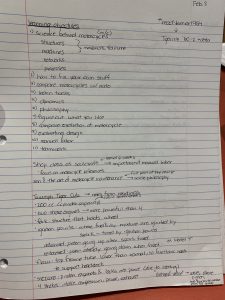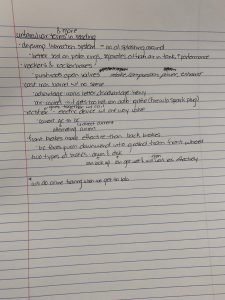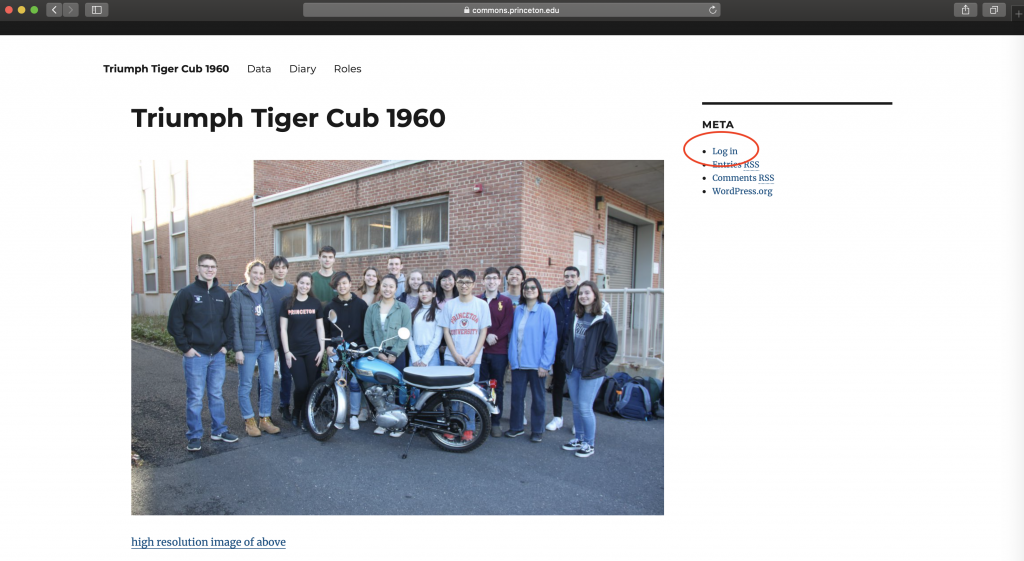I. GFCI Outlets
- GFCI stands for ground fault circuit interruptor.
- The outlet works by sensing the current flowing in both the neutral (return) and live (outbound) wires.
- If the current differs by a given amount, this indicates that current is flowing to ground through another medium (i.e. you), and the outlet will break the circuit in hopes of saving your life.
- GFCI outlets are required in all U.S. kitchens and bathrooms.
II. Recap from Monday
- Carburetor Group
- Brought the ’58 motorcycle to the machine shop with Glen and “did a lot of weighing.”
- They couldn’t get this cycle started due to a spark plug issue they’re hoping to diagnose today.
- Detailing Group
- Learned about the intricacies of combustion engines with Glen, realizing just how many things have to work cohesively at the same time for successful operation.
- Prepped many parts for painting using a “sandable” primer.
- Engine Group
- Sorted a lot of nuts and bolts in hopes of finding Whitworth hardware in the miscellaneous bin.
- Discovered that one of the downsides of fine threads (like Whitwork bolts) is an increased possibility of cross threading.
- Put the carburetor back on the blue motorcycle to get it running and check for leaks.
- Front Fork Group
- Restrictor rod was stuck in the bottom of the frame tubing, but they were able to remove it with the help of Professor Littman
- Fluids
- Continued taking apart the engine on the green cycle.
- Still trying to access the oil pumps on this cycle.
- Learned about the three different fluid chambers/compartments that oil flows through.
- Frame Group
- Accidentally bent the swing arm on the frame while using the hydraulic press.
- Will hopefully fix this issue today or figure out another solution.
- Electrical
- Learned about the GFCI outlets as mentioned above and fixed a broken one in the lab.
- This outlet uses torx screw heads, which is an uncommon head type that is used for security purposes and anti-tampering.
- Found out that the horn they found does work, but it sounds impressively wimpy.
III. How Fast Can the Motorcycle Go?
- Maximum Speed
- The theoretical maximum speed can be determined using the engines RPM at maximum power output and the radius of the rear wheel.
- @ 6000RPM, a gearing ratio of about 6.35, and a rear wheel radius of 1ft, we calculated the theoretical max speed to be about 98 feet/second.
- Friction
- The maximum power the cycle can transmit to the road is dependent on the frictional force that prevents the wheel from slipping.
- The frictional force can be calculated by multiplying the normal force of the ground on an object by the coefficient of friction (μ).
- The coefficient of friction is about 1 between dry asphalt and a rubber tire, and about .2 for metal on metal.
- Using our friction calculations, we found that, theoretically, the cycle could accelerate to 60mph in 6 seconds.
- In general, an AWD/4WD vehicle will have more friction and be able to accelerate faster than a 2WD vehicle.
IV. Discussion on Zen Chapters 10, 11, and 12
- Chapter 10
- “Science is a temple” and Phaedrus uses it for “escapism into rationality”
- Phaedrus was expelled from his university at age 17.
- Chapter 11
- As you increase in altitude, there is less oxygen in the air so the engine can’t intake enough to keep up with normal fuel intake. You have to adjust the amount of fuel accordingly based on altitude.
- A Backfire is an explosion outside of the engine either in the intake or the exhaust.
- If the cycle backfires in the exhaust, it’s running too rich on fuel. If the cycle backfires in the intake, it’s running too lean on fuel.
- Kant and Hume in connection to motorcycle maintenance. A key highlight was the idea that knowledge is a result of the senses.
- Chapter 12
- The character Deweese was introduced, who is an old friend of Phaedrus (who no longer exists in the literary present).
- Chris is nervous to interact with Deweese given the awkward nature of his father’s relationship with the man.
- Talked about the Meta nature of the book, especially when the author attempts to justify not giving John or Sylvia a significant backstory.







